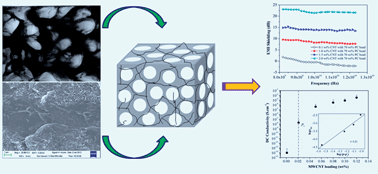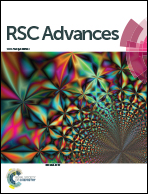A strategy to achieve high electromagnetic interference shielding and ultra low percolation in multiwall carbon nanotube–polycarbonate composites through selective localization of carbon nanotubes†
Abstract
Here, we report a simple method that involves solution blending of polycarbonate (PC) in the presence of multiwall carbon nanotubes (MWCNTs) and commercial PC beads for the preparation of electrically conducting MWCNT–PC composites with high electromagnetic interference shielding effectiveness (EMI SE) and electrical conductivity at very low (∼0.021 wt%) percolation threshold (pc). Thus, electrical conductivity of ∼4.57 × 10−3 S cm−1 was achieved in the MWCNT–PC composites at an extremely low MWCNT loading (0.10 wt%) in the presence of 70 wt% PC beads in the composites. Finally, optimizing the ratio of PC beads and MWCNT loading in the composites, a very high EMI SE value (∼23.1 dB) was achieved at low loading (2 wt%) of MWCNT with 70 wt% PC beads. The effective concentration of MWCNT increases in the solution blended PC region with increasing the amount of PC beads. Thus, a strong interconnected conductive network structure of CNT–CNT is developed throughout the matrix and the presence of strong π–π interaction among the electron-rich phenyl rings of PC and MWCNT in the composites plays a crucial role in increasing the EMI shielding value and electrical conductivity of the MWCNT–PC composites.


 Please wait while we load your content...
Please wait while we load your content...